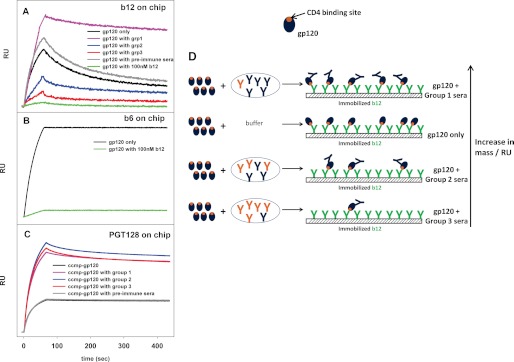FIGURE 6.

Competition binding assays of gp120 to immobilized monoclonal antibodies. A, b12; B, b6; C, PGT128. For b12 and PGT128, competition was carried out in the presence of antibodies purified from various sera. Binding was monitored by surface plasmon resonance. Prebinding of gp120 to sera from groups 2 and 3 resulted in reduced binding to b12, indicating the presence of substantial amounts of CD4 binding site antibodies. Prebinding to group 1 serum, however resulted in increased binding to b12, possibly due to large amounts of antibodies directed at epitopes other than the CD4bs in this serum. As a negative control, none of the sera showed any competition to PGT128. For all antibodies, incubation of gp120 with preimmune sera showed similar binding as gp120 alone, indicating the absence of gp120-specific antibodies in the preimmune serum. In B, binding of the neutralizing CD4bs antibody b12 prevents binding of the non-neutralizing CD4bs antibody b6. D, a schematic representation of the possible events during the b12 competition assay. CD4 binding site antibodies are shown in orange, whereas those that are directed toward epitopes other than CD4bs are shown in blue. Because the latter do not compete for the b12 binding site, gp120 precomplexed to these antibodies retains its ability to bind b12. The amount of CD4bs Abs increases going from group 1 to group 3, resulting in a gradual reduction in b12 binding in the competition assay. RU, resonance units.
